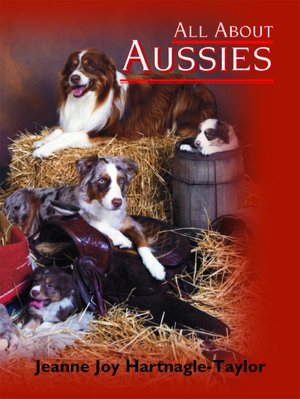 The Standards were taken from the book “All about Aussies” by Jeannie Joy Hartnagle.
The Standards were taken from the book “All about Aussies” by Jeannie Joy Hartnagle.
Head: Clean cut, top skull flat to slightly rounded; equal in length and width to muzzle which tapers slightly to rounded tip; well-defined but moderate stop. Muzzle in balance and proportion to rest of head.
Lips: Snug and not hung below the line of the mouth.
Teeth: Lower incisors close just behind upper incisors. Fault: An even bite. Disqualification: Undershot bite, overshot bite.
Eye: Almond shaped, average size well apart, not sunken or prominent. Eyes may be in any combinations which include flecks or marbling; no precedence should be given to one eye color or combination. Fault: Offset pupil.
Ears: Moderate length, slightly rounded tip, breaking slightly forward to above base. Ears should be in proportion to dog. Must have color. Fault: Hound type and prick.
Forequarters: Shoulder blades long and flat, close set at withers. Upper arms attached at approximate right angle to shoulder line with forelegs dropping straight, perpendicular to ground. Legs straight. Pasterns short and strong but flexible showing slight angle.
Feet: Oval and compact with well arched toes. Fault: Splayed feed, broken down feet. Dewclaws on front legs matter of preference – not bearing on judging in the show ring.
Neck and Body: Neck in proportion with body. Slightly arched, well set into shoulders. Body firm and muscular.
Topline: Broad and level.
Chest: Deep and strong, ribs well sprung.
Loin: Strong and broad when viewed from top.
Bottomline: Moderately tucked up.
Croup: moderately sloping.
Tail: Straight, natural bobtail or docked not to exceed 3 inches. Toy under 1 inches. Fault: Roached back, weak and sagging.
Hindquarters: Width approximately equal to width of forequarters.
Hock Joints: Moderately bent.
Stifles: Clearly defined.
Metatarsi: Short perpendicular to ground and parallel to each other when slightly wavy, moderate length with undercoat. Quality of undercoat will vary with climate. Short and smooth on head, outside of ears, front of forelegs and below hocks. Backs are moderately feathered; breeches moderately full. Moderate mane and frill which is more pronounced in male dogs than bitches. Fault: Non-typical coats.
Color: Blue merle, black tri (black, copper & white), red merle, red tri (red, copper & white), solid red or black all with or without white marks. Tan or copper points with no preference. Colors strong, clear and rich.
All Colors: No white areas around eyes and ears – no white body. Hairline of white color not to exceed point of wither.
Patterns: Vary from roan base, splotches and bold patches. Each color may be with or without white and/or coppers markings. White trim is acceptable color pattern appearing in well-defined areas: forehead, neck, muzzle, chest stomach, feet and legs.
Black: Is black, no sabling to undercoat
Blue Merle: Modification black body color, sometimes referred to as salt and pepper, can vary in combinations of blue, silver blue, steel gray or blue black. Black nose.
Red: Deep liver, burgundy, shaded rust or sorrel.
Red Merle: Variation basic red body color (cinnamon and sugar) with liver skin pigmentation. Color can be extremely contrasting to evenly blended. Disqualifications: Other tan recognized colors; white body and/or splashes of white, duddley nose. Butterfly nose not faulted under 1 year of age. One third or more white body color.
Gait: Smooth, free, well-balanced ground covering stride. Front and hind legs move straight and parallel with centerline of body, topline remains level. Gait evaluated at trot. Joint not to bend or twist when in motion.
Size: Quality not to be sacrificed in favor of size. Length in proportion to height.
Miniature: 13 to 17 inches tall.
Toy: 13 inches and under. Finer bone than the Miniature, more a house pet and/or working small livestock or fowl. Disqualifications: Monorchidism and cryptorchidism. No sound reason for size disqualification. No sound reason for size disqualification.
Grooming: Shown in near to natural state.
Feet: Hair trimmed away from and around pads.
Whiskers: Trimmed or not trimmed. Never removed on dog to work stock.
Hair: Pasterns trimmed between heel and digital. Long hairs on docked on bobtails may be removed to make a neater appearance. Sparse, stray and straggly hairs removed to make a neater outline.
